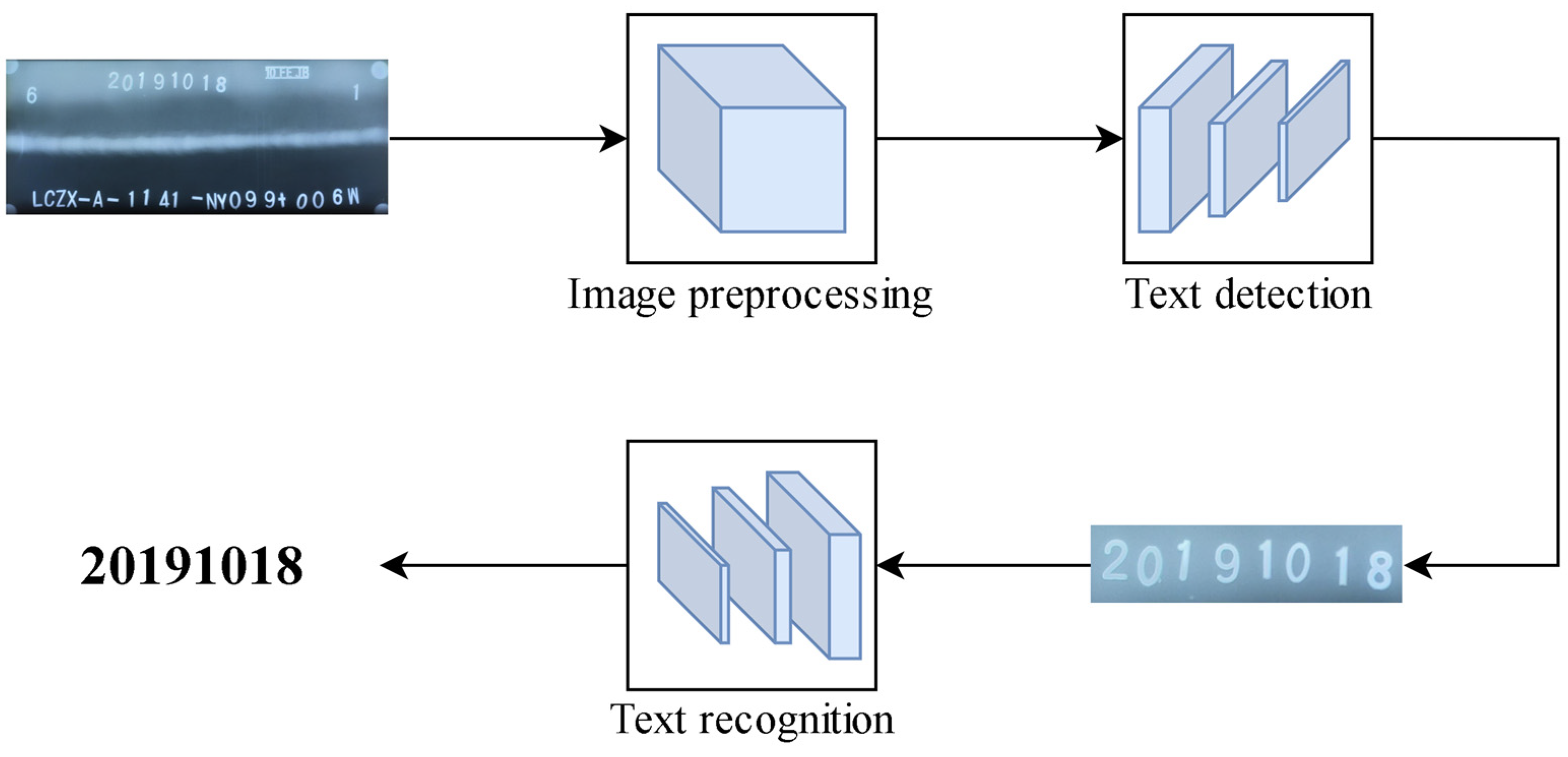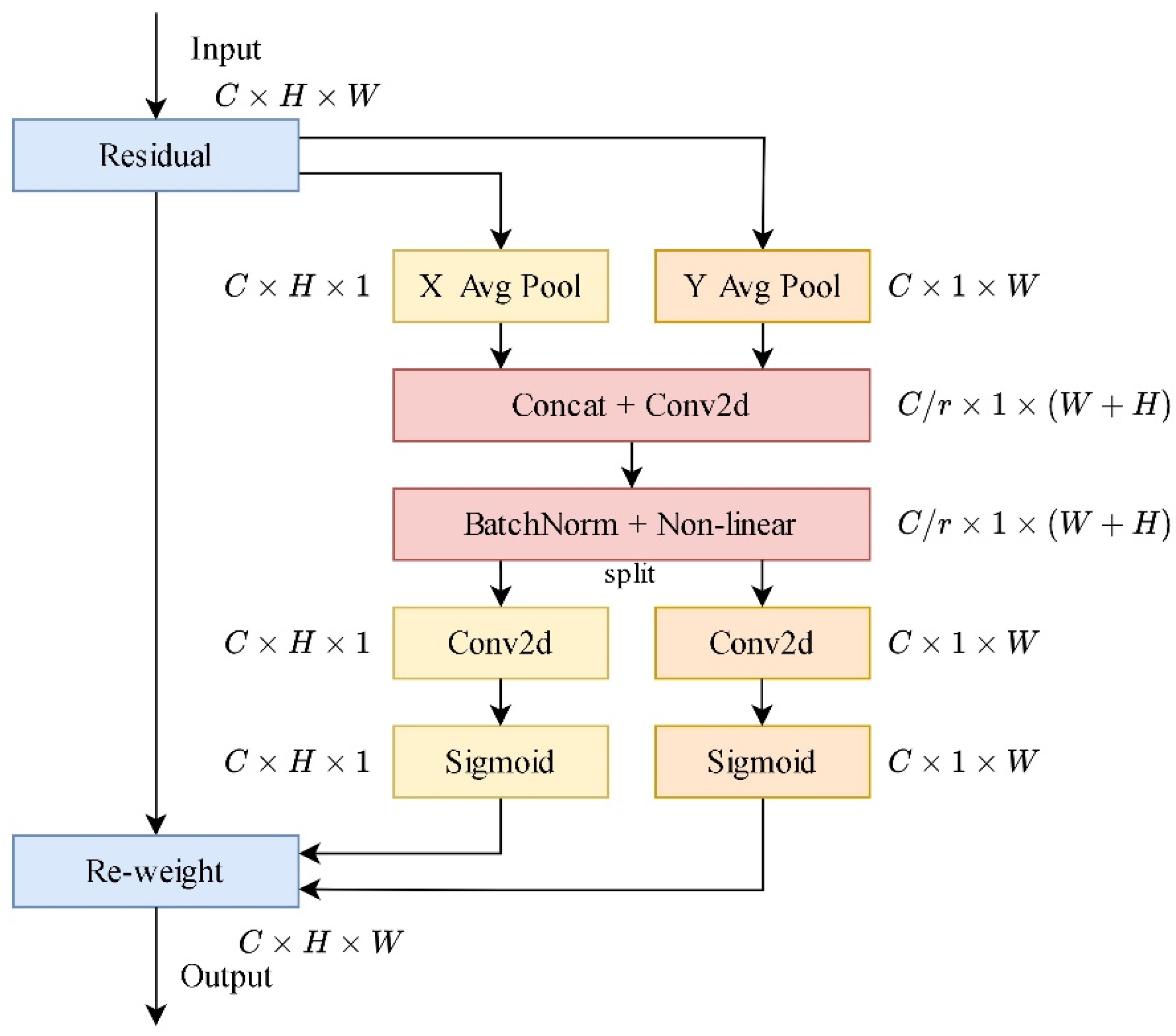1. Introduction
With the widespread application of modern welding technology in industrial manufacturing, there is an increasingly urgent demand for the automated analysis and processing of weld seam images. The text information in weld seam images contains important welding parameters, workpiece identification, and other key information such as dates, weld seam serial numbers, and positioning symbols. However, digitizing weld seam images often requires manually inputting specific numbering, which is inefficient and inconvenient for secondary queries. Accurately detecting and recognizing text in weld seam images can automate the collection of information from these images, greatly enhancing work efficiency. Additionally, timely access to relevant information from weld seam images facilitates subsequent work. Therefore, text detection and recognition in X-ray weld seam images hold significant theoretical and practical significance.
The recognition of text information in weld seam images can be divided into two key steps: text detection and text recognition. This division allows for the independent improvement of models for text detection and text recognition, thereby enhancing the overall accuracy of the recognition process. Text detection aims to extract connected text regions from weld seam images and form continuous text lines, while text recognition focuses on identifying semantically meaningful text characters within these text lines.
Traditional text detection and recognition methods (such as edge detection, sliding windows, template matching, etc.) have been widely applied to general text recognition tasks, performing well primarily on well-structured printed documents. However, their robustness is compromised when dealing with complex scenarios involving blurry images, low contrast, and other challenging conditions, making it difficult to achieve accurate detection and recognition.
With the rapid development of deep learning, the performance of text detection and recognition tasks has significantly improved. In the field of text detection, CTPN [
1] is a text detection method that combines convolutional neural networks (CNNs) and recurrent neural networks (RNNs). It utilizes a vertical anchor mechanism to predict scores for candidate regions, enabling the detection of blurred text in natural scene images. However, its effectiveness in detecting skewed text is limited. Mask R-CNN [
2], widely used in image segmentation, also performs well in text detection applications, excelling in recognizing irregularly shaped text instances. However, it struggles with small-sized or sparse text instances. PSENe [
3] is a progressive scale expansion network that generates a series of masks of different sizes from a base image for feature fusion and text line prediction. It effectively addresses the issue of overlapping detections in cases of small text line spacing but suffers from slow detection speeds. FCENet [
4] proposes representing the bounding curve of text using the parameters of the Fourier transform. This method improves the detection accuracy of highly curved text instances in natural scene text detection. However, its performance in non-curved text detection is average. DBNet [
5] addresses the time-consuming post-processing issue associated with threshold-based binarization in segmentation-based methods. It introduces a learnable threshold and designs a binarization function approximating a step function, allowing the segmentation network to learn the threshold during training. This not only improves the accuracy but also simplifies the post-processing. DBNet++ [
6] builds upon DBNet by incorporating the ASF module to optimize the performance of multiscale segmentation, enhancing text detection. However, both DBNet and DBNet++ exhibit suboptimal performance when dealing with long text instances.
In the field of text recognition, ASTER [
7] is a text recognition method with flexible correction capabilities. It employs a spatial transformer network to rectify input images with irregular text and utilizes a sequence recognition network based on attention mechanisms to achieve end-to-end text recognition. However, its recognition performance is constrained by the geometric features of the characters, and the model is susceptible to background noise. SAR [
8] addresses irregular text scenes by proposing a weakly supervised approach that utilizes a two-dimensional attention mechanism module for character localization and individual recognition. It does not require character-level annotations, effectively enhancing the recognition accuracy of irregular text. However, the model training process is complex, leading to longer training times.
MASTER [
9] adopts a multi-directional non-local self-attention module to address attention shift issues. During training, adjustments are made, and by creating a lower triangular mask matrix, the decoder can simultaneously output predictions for all the time steps, improving the training parallelism and significantly reducing the training time. However, the implementation cost is higher. ABINet [
10] introduces a novel bidirectional cloze network (BCN) based on bidirectional feature representation as a language model. It iteratively corrects the features obtained from the visual model, effectively mitigating the impact of noisy inputs and achieving good performance on low-quality images. However, it faces challenges in achieving fully accurate recognition in long text lines with numerous characters. MATRN [
11] enhances the text recognition performance by spatially encoding semantic features, connecting semantic features and visual features, and performing cross-modal feature enhancement on both feature types.
Furthermore, end-to-end natural scene text recognition methods based on deep learning integrate text detection and recognition tasks into a unified network model. STAR-Net [
12] combines a spatial attention mechanism and residual connections to effectively capture and utilize the spatial information from input images for accurate text recognition. However, it struggles to accurately locate the text regions in blurry or low-resolution text images. TextNet [
13] has developed a scale-aware attention mechanism, which learns from multiscale image features as the backbone network, sharing fully convolutional features and computations for localization and recognition. This approach is applicable to both regular and irregular text but exhibits mediocre performance in recognizing curved text. Lyu et al. introduced Mask TextSpotter [
14], an extension of Mask R-CNN, which adds an additional branch for single-character instance segmentation after RoI Align. Text recognition in this method depends on single-character classification from this branch. It is capable of detecting and recognizing text of arbitrary shapes but requires character-level annotations during training. Liao et al. proposed Mask TextSpotter v3 [
15], which employs a Segmentation Proposal Network (SPN) instead of an RPN to predict salient maps for arbitrary-shaped text. Subsequently, a Hard RoI Masking operation is performed based on the mask of each text region, significantly improving the model’s shape robustness for detecting arbitrary-shaped text. Yue et al. introduced RobustScanner [
16] to address attention drift issues. This method proposes a novel position-enhanced branch and dynamically integrates its output with the decoder attention module output, offering improved robustness and practicality. While end-to-end methods simplify the overall model design and training process, debugging and optimization may consequently become more challenging.
In this study, we encountered challenges such as the complex backgrounds, high contrast, and brightness differences in the X-ray weld seam images, leading to significant visual differences between the text and background. Additionally, factors like irregular engineering operations may cause the text in weld seam images to appear blurred, distorted, and with varying lengths of text lines. To achieve good detection and recognition results under these interferences, we first constructed two datasets for the text detection and recognition tasks. Then, through a series of experimental analyses, we employed the DBNet model for text detection tasks and improved the post-processing methods to enhance the text detection accuracy. For text recognition tasks, we adopted the MATRN model and enhanced the model performance by introducing the CA [
17], CBAM [
18], and HFA [
19] modules, thus improving the text recognition accuracy. Finally, the experimental results demonstrate that the proposed method performs excellently in adapting to the unique scenario of X-ray weld seam images.
The main contributions of this paper are as follows:
Through experimental analysis, we employed the DBNet model for weld seam image text detection and combined it with post-processing methods to improve the detection accuracy.
We improved the MATRN model, achieving a higher text recognition accuracy when targeting weld seam image datasets compared to other reference models. Our improved model also outperforms the original model in comparison with publicly available datasets.
We introduced a CA module into the backbone network to better extract visual features, thus enhancing the model performance. Additionally, we integrated the CBAM and HFA modules into the position attention module for more accurate spatial localization of characters, thereby improving the model’s recognition accuracy.
4. Conclusions
This paper introduces a deep-learning-based algorithm for text recognition in X-ray weld seam images, successfully achieving automated recognition of the textual information in X-ray weld seam images. The algorithm comprises two key components: text detection and text recognition. Firstly, the text detection model accurately locates the positions of the text lines. Subsequently, these text lines are extracted from the weld seam images, and text recognition is performed, ultimately yielding precise text recognition results. By incorporating post-processing techniques into the text detection model, we achieve accurate detection of partially longer text lines, achieving an accuracy of 91.0%, a recall of 92.4%, and an F1 score of 91.7% on the test dataset.
In the text recognition phase, we introduce modules such as CA, CBAM, and HFA to further enhance the accuracy of the text recognition. Compared to other advanced algorithms, our text recognition algorithm demonstrates excellent performance on the test dataset, achieving a text line recognition accuracy of 93.4%. However, it is essential to note that challenges exist in weld seam images, and our recognition algorithm may encounter issues in accurately recognizing characters with tightly connected text lines, as shown in
Table 3. Therefore, further research on accurately recognizing densely arranged characters remains a crucial direction for future studies.




















